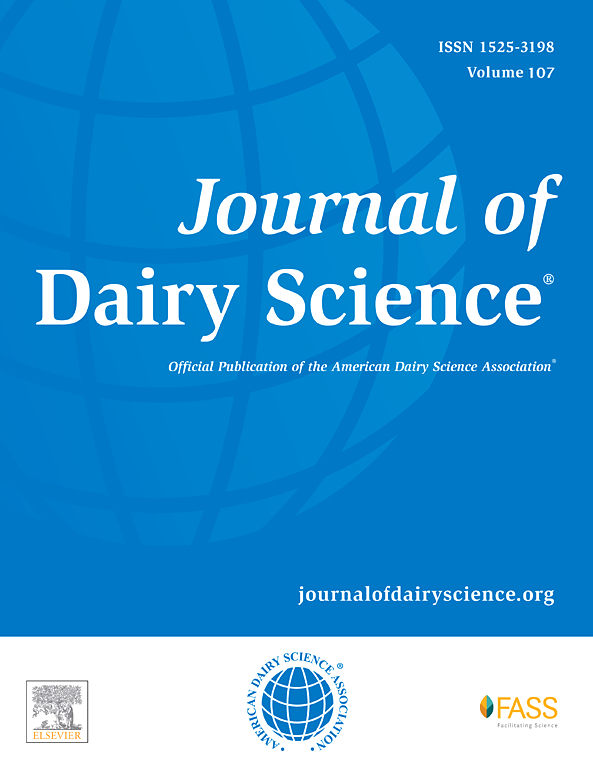Potential of anogenital distance as a genetic selection trait in Canadian Holsteins
IF 3.7
1区 农林科学
Q1 AGRICULTURE, DAIRY & ANIMAL SCIENCE
引用次数: 0
Abstract
Maintaining optimal fertility in dairy cattle herds is a global challenge that is typically addressed through the genetic selection of fertility indicator traits. However, many of the traits currently implemented in breeding programs are heavily influenced by environmental factors, resulting in a slow rate of genetic improvement. Anogenital distance (AGD) has recently emerged as a promising fertility indicator trait due to its association with favorable reproductive outcomes and its higher heritability estimates compared with currently evaluated traits. This study aimed to enhance the understanding of AGD's genetic potential by estimating its genetic parameters in Canadian Holsteins, assessing the reliability of breeding values, comparing pedigree BLUP to single-step genomic BLUP approaches, and estimating the correlation between AGD breeding values and those of currently evaluated traits. The dataset used in this study comprised 5,541 Canadian Holstein cows and heifers from 20 herds, collected between 2015 and 2020. The final dataset consisted of 4,988 animals with AGD phenotypes after filtering. The pedigree-based heritability estimate for AGD was 0.39 ± 0.04, whereas the incorporation of genomics resulted in a lower estimate of 0.37 ± 0.03. The reliability of estimated breeding values ranged from 0.49 ± 0.03 for phenotyped animals to 0.81 ± 0.05 for proven sires with at least 30 phenotyped daughters. The integration of genomic information improved the reliability of breeding values, with gains ranging from 0.01 gain for proven sires to 0.14 relative gain for unproven sires. High gain in observed reliability for females without records was demonstrated when genomic information was included, using both split forward validation (0.26) and 5-fold cross-validation (0.14). The AGD breeding values showed moderate unfavorable correlations with relative breeding values of age at first service and production traits including milk yield, fat yield, and protein yield. This suggests that AGD may influence reproductive maturity in heifers but could also have an unfavorable association with production traits, highlighting the need for balanced breeding strategies that consider both fertility and production outcomes. Future studies should aim to expand phenotype data across lifetimes and breeds and estimate genetic correlations with traditional reproduction and production traits using multitrait models.
肛门生殖器距离作为加拿大荷斯坦犬遗传选择性状的潜力。
保持奶牛群的最佳生育能力是一项全球性挑战,通常通过生育指标性状的遗传选择来解决。然而,目前在育种计划中实施的许多性状受到环境因素的严重影响,导致遗传改良速度缓慢。由于与良好的生殖结果相关,并且与目前评估的性状相比具有更高的遗传率,肛门生殖器距离(AGD)最近成为一种有希望的生育指标性状。本研究旨在通过估算加拿大荷斯坦犬AGD的遗传参数,评估育种值的可靠性,比较纯种BLUP与单步基因组BLUP方法,以及估计AGD育种值与目前评估性状之间的相关性,来提高对AGD遗传潜力的认识。本研究中使用的数据集包括2015年至2020年间收集的来自20个畜群的5541头加拿大荷斯坦奶牛和小母牛。筛选后的最终数据集包括4988只具有AGD表型的动物。基于家系的AGD遗传力估计值为0.39±0.04,而结合基因组学的估计值较低,为0.37±0.03。估计育种值的可靠性范围从表型动物的0.49±0.03到至少有30个表型子代的已证实的母猪的0.81±0.05。基因组信息的整合提高了育种值的可靠性,其增益范围从已证实品种的0.01增益到未证实品种的0.14相对增益。使用分裂前向验证(0.26)和5倍交叉验证(0.14),当包含基因组信息时,没有记录的女性观察到的可靠性获得了高增益。AGD育种值与初龄、产奶量、脂肪量、蛋白质产量等生产性状的相对育种值呈中度负相关。这表明,AGD可能会影响小母牛的生殖成熟度,但也可能与生产性状有不利的关联,强调需要兼顾生育力和生产结果的平衡育种策略。未来的研究应旨在扩大整个生命周期和品种的表型数据,并使用多性状模型估计与传统繁殖和生产性状的遗传相关性。
本文章由计算机程序翻译,如有差异,请以英文原文为准。
求助全文
约1分钟内获得全文
求助全文
来源期刊

Journal of Dairy Science
农林科学-奶制品与动物科学
CiteScore
7.90
自引率
17.10%
发文量
784
审稿时长
4.2 months
期刊介绍:
The official journal of the American Dairy Science Association®, Journal of Dairy Science® (JDS) is the leading peer-reviewed general dairy research journal in the world. JDS readers represent education, industry, and government agencies in more than 70 countries with interests in biochemistry, breeding, economics, engineering, environment, food science, genetics, microbiology, nutrition, pathology, physiology, processing, public health, quality assurance, and sanitation.
 求助内容:
求助内容: 应助结果提醒方式:
应助结果提醒方式:


